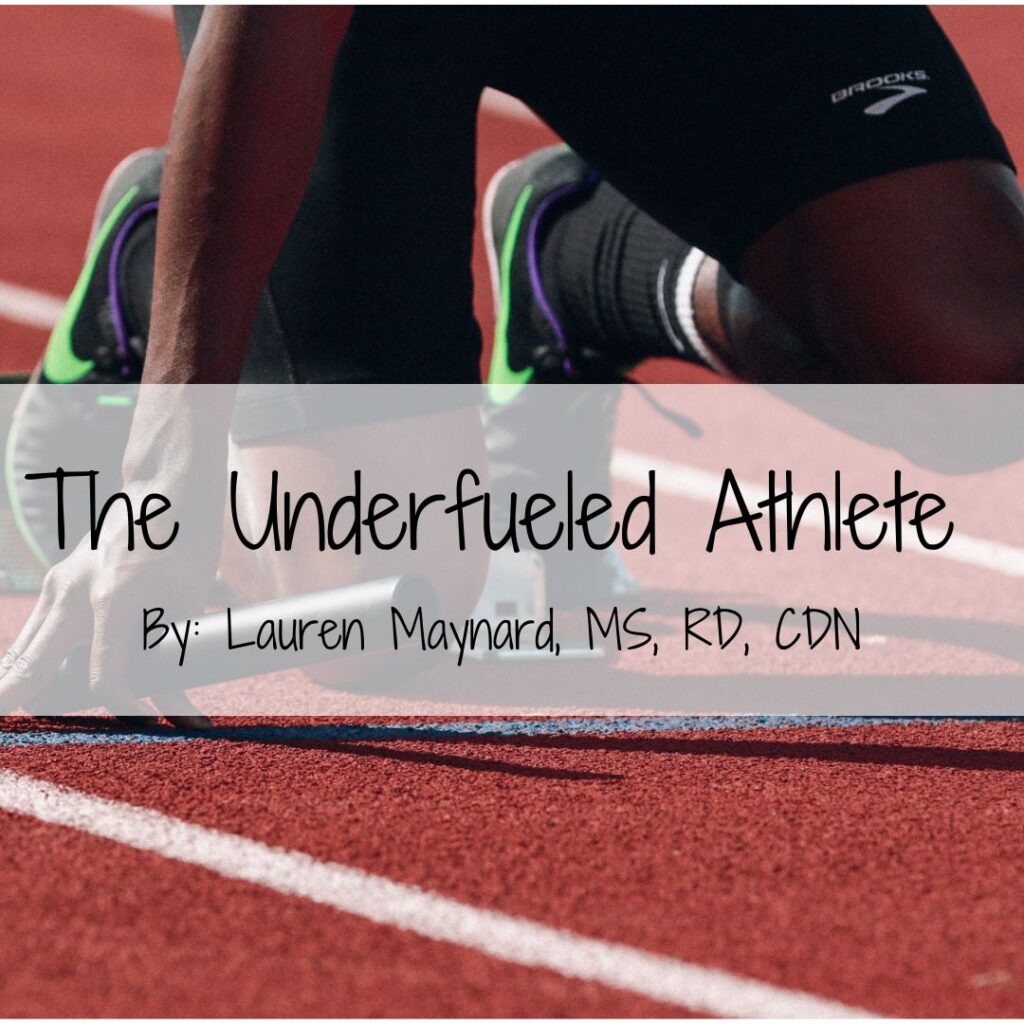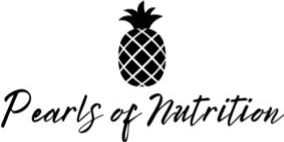
As a former female athlete, I am passionate about conversations around athletic performance, nutrition, self-care and body image. Here at Pearls of Nutrition we love speaking with athletic teams and encourage coaches, trainers, and parents to include a Registered Dietitian that specializes in athletics and disordered eating in the conversation.
There’s no denying that nutrition and training play a huge role in athletic performance. What we have to separate is the idea that weight or a specific body image dictate performance equally for every person. Too often, athletes of all ages are misinformed on what a beneficial combination of fuel and movement should like. The intent of wanting to change or control body composition through a lens of weight loss alone can be detrimental, not only for performance but also for physical and mental health.
Body Composition
So, what does weight actually mean?
Body weight encompases:
- Muscle tissue
- Bone mass
- Organ mass
- Fat mass
- Water
Athlete or not, anyone with a goal of “weight loss” must understand that the number on the scale is not the most important factor. Athletes in particular must know what else comes with weight loss.
I love this visual from Dan Bernardot, PhD, RD, FACSM:
“Imagine an athlete who was asked to lose 4 pounds. After his or her weight loss efforts, the athlete was assessed and found to have lost 4 pounds of fat and gained 4 pounds of muscle. Weight would be the same, but the strength-to-weight ratio would be better…more muscle would be moving less nonmuscle weight. As a result, performance would likely improve. However, if weight were the only measured metric, this athlete would have been deemed a failure for not complying with the weight-loss mandate. Now, imagine that the athlete lost 3 lbs of muscle and 1 lb of fat to meet the target weight. The loss of muscle would lower the strength-to-weight ratio, and there would be less metabolically active tissue with which to burn consumed energy, making an increase in fat mass more likely. This athlete would be considered a success for having achieved the target weight but would have lowered athletic performance in the process. Again, weight is the wrong metric”
Most weight-loss recommendations stem from the BMI chart alone. I could write an entire blog post on the misunderstanding of BMI, but I will save some time and link fabulous resources at the end that have done this for me! As dietitians, we too often see BMI-based recommendations that are inappropriate and unsupportive for individuals. We have to start asking better questions and see people as a whole person.
Reality of Weight Change
For adolescents, we have to remember that growth and development are the body’s primary goals at this time, so weight cannot be used as a standalone metric to dictate nutrition and exercise regimens. We would expect to see weight increase as bone density, height and all other areas of growth to increase. In fact, if you look at a pediatric growth chart, we expect to see weight continuing to increase into early 20s despite height leveling off around 14 years old. Even though adults are no longer growing in height, for most after age 30 muscle mass and bone density begin to decrease, so again weight is not the right metric alone.
What happens if we do lose weight? Thinking back to Dr Bernodlt’s example, we see that weight loss does not mean fat mass loss alone. We lose stored carbohydrates (energy), water, and muscle when we lose weight. This is not ideal for anyone, regardless of athletic role. After this total loss, something called adaptive thermogenesis occurs which is a fancy way to describe our body saying, “Oh sh*t, we must be starving. Not doing that again” and slows down metabolism. It is now easier to return to our original weight with less energy (calories) consumed. Inadequate nutrition also increases cortisol (a stress hormone), which leads to additional loss of bone and muscle mass. Do we see how disordered eating and dieting can be a dangerous and frustrating cycle?
As an athlete, maintaining muscle strength can be of utmost importance to sports performance, this is simply not possible to do when you are underfueling.
RED-S
For athletes, inadequate nutrition can become increasingly detrimental. Relative energy deficiency in sport or RED-S is a disorder in which an athlete or anyone engaging in physical activity is underfueling and/or overexercising, which in turn impairs how the body operates. When we lack adequate energy the body starts to alter important processes.
There is a fine line between focusing on nutrient dense foods and upholding adequate training before it becomes disordered, obsessive and harmful. Performance and personal pressures are real, I get it, but there are better ways to support performance without overtly damaging our bodies. Coaches, parents, medical professionals and athletes should all be aware of the following warning signs or RED-S:
- Disordered or restrictive eating
- Weight loss
- Lack of normal growth/development
- Frequent illness
- Recurrent injuries
- Cardiac abnormalities
- Decreased performance
- Exercise beyond requirement
- Mood changes/irritability
- Decreased concentration
- *Amenorrhea/menstrual dysfunction and hormone changes
*Bone health & hormone changes for men and women, take a huge hit with chronic underfueling. Peak bone health for women occurs at around age 19 and for men around 20-21. For women specifically, inadequate nutrition can trigger the loss of menstrual periods (amenorrhea) through decreased sex-hormone production and results in low estrogen. In men, we tend to see a reduction in the amount of testosterone produced. These both can result in the loss of bone mass, which can lead to stress fractures and/or life-long weakened bones including osteoporosis/osteopenia. This can be particularly dangerous for athletes in contact sports or sports that involve running, jumping, or jostling (lookin’ at you, equestrian).
If you have worked with me, you know I love to use the woodstove analogy:
Say you heat your house with a woodstove and you run out of wood. You decide to tear down your walls for firewood. Well, you’d have a fire but still be cold as heck because you no longer have any walls. Pretty inconvenient. Same goes for what happens internally with prolonged periods of inadequate fuel/“firewood”. The benefits of physical activity and muscle growth/maintenance occur only when we are sufficiently fueling ourselves and taking enough time to rest and recover.
Recovery
To put it simply, the sooner physical recovery is reached the better. The recovery process may be different for everyone but for all will include renourishing the body (including correcting any nutrient deficiencies or inadequacies, restoring weight if appropriate, and finding a balance in exercise volume and intensity. Most of you who are reading and relating to this topic (whether it be you or a loved one) can imagine how difficult the thought of any change in movement and/or nutrition may feel. This can be extremely difficult and takes an individualized and supportive approach, so we highly encourage working with a Registered Dietitian and team who can assist in this process.
Some goals that may be discussed in the recovery process:
- Increasing rest days
- Reducing cardio/HIIT exercises and shifting to strength training
- Increasing nutrition based on your individual needs
- Incorporating different forms of movement to strengthen the body like yoga, pilates, and stretching
- Some athletes may require a pause in all physical activity based on what is appropriate for their recovery
- Supplementation of specific vitamins and minerals
- Increasing variety of foods consumed
What about the “non-athlete”?
What if you are not an endurance runner, Crossfit connoisseur, high school, college or professional athlete? All of the above concepts still apply to you! It may be time to take a deeper look into the relationship you have with your body. How much rest are you allowing yourself? How well are you recovering? Are you noticing any restrictive, excessive or compulsive behaviors around food/movement? Do you feel guilt or shame if you miss a workout or eat certain foods? Think back to your intention and your why. Everyone deserves to have the knowledge and resources to support your mental and physical health.
Checkout a post here from eating disorder specialist and colleague, Kelly Ogdon, MS, RD, CD-N for a great read on understanding your hunger & fullness cues & here for a deeper look at nutrition during menstruation, written by eating disorder specialist and colleague, Karlee Bushnell, RD, CD-N.
As promised, resources on BMI are attached below!
Also, a really nice image/summary of underfueling’s effect on performance and health.
BMI Resources:
Other Resources:
D. Benardot; Advanced Sports Nutrition (Third Edition). 2021


